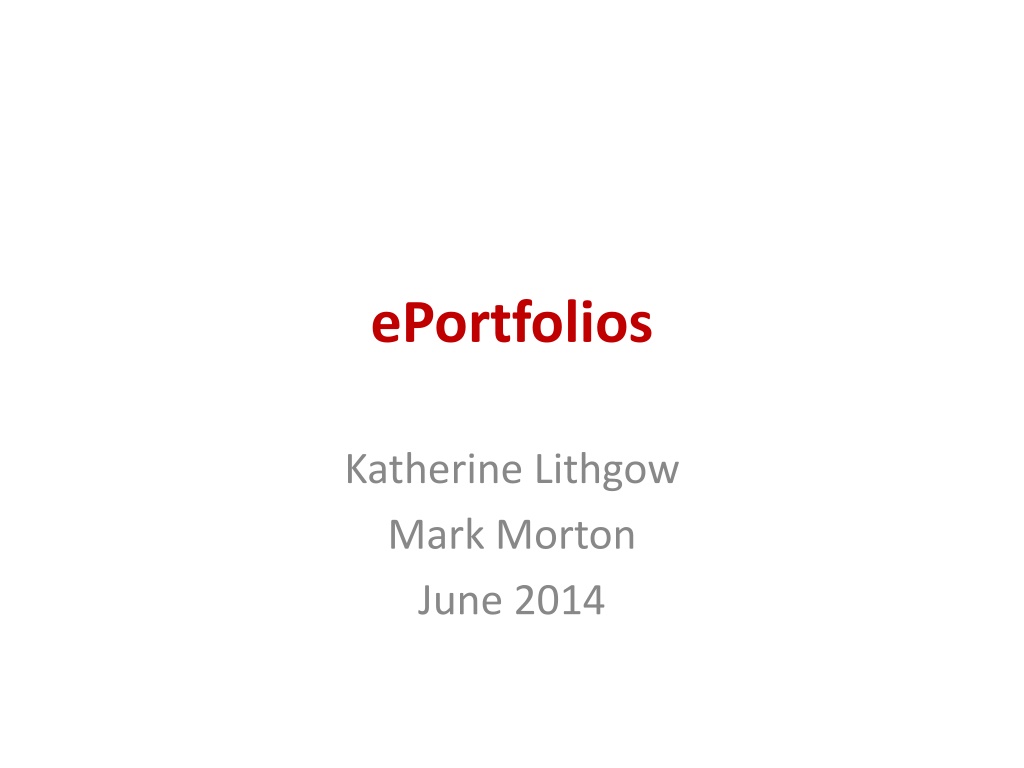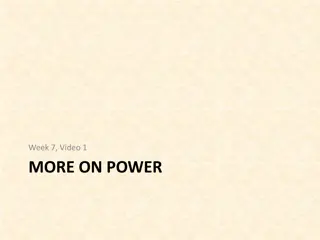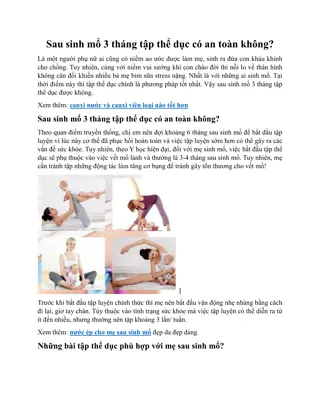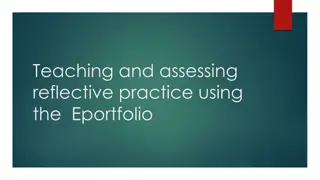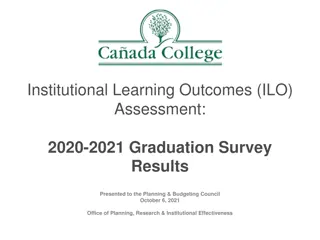Exploring the Power of ePortfolios in Education
Discover the significance of ePortfolios in education, including their definition, benefits, concerns, implementation strategies, and key takeaways. Dive into examples, learning theories, and student perspectives to understand the dual role of ePortfolios as products and processes, fostering deeper learning and reflection.
Download Presentation

Please find below an Image/Link to download the presentation.
The content on the website is provided AS IS for your information and personal use only. It may not be sold, licensed, or shared on other websites without obtaining consent from the author.If you encounter any issues during the download, it is possible that the publisher has removed the file from their server.
You are allowed to download the files provided on this website for personal or commercial use, subject to the condition that they are used lawfully. All files are the property of their respective owners.
The content on the website is provided AS IS for your information and personal use only. It may not be sold, licensed, or shared on other websites without obtaining consent from the author.
E N D
Presentation Transcript
ePortfolios Katherine Lithgow Mark Morton June 2014
Todays Overview What is an ePortfolio? Why document learning with ePortfolios? Examples of ePortfolio implementation Different kinds of ePortfolios Learning Theory behind ePortfolios Activity: Planning for effective implementation What do students say? Review Catalyst for Learning research and resources on ePortfolios
Benefits and Concerns What do you know about ePortfolios? What benefits do you think you will gain by using an ePortfolio? How will your students benefit from an ePortfolio? What concerns do you have about using an ePortfolio? What concerns do you think your students will have?
Key Take-Aways Clearly Defined Learning Outcomes ESSENTIAL for Success Implementing ePortfolios an Iterative Process ePortfolio Implementation Framework Identify Stakeholders and Work with Them to Meet Needs Important for buy-in/support Pedagogy MUST Lead Technology It s About Learning, Not Tools Start Small and Plan Ahead You don t need to change the whole campus today but you do have to know where you are going
What is an ePortfolio? Let s start with an example: http://solangebonilla.myefolio.com A screencast overview of another good ePortfolio is here.
What is an ePortfolio? A digital collection of artifacts that belong to or represent a person, such as essays, posters, photographs, videos, artwork, and other course-related assignments; volunteer experiences, employment history, and extracurricular activities. All of the above are products.
What is an ePortfolio? But ePortfolios are also a process. The process of generating new or deeper learning by reflecting on one s existing learning and/or experiences.
What is an ePortfolio? So an ePortfolio is both a product and a process: 1. It presents the products of a learning experience Essays, posters, artwork, and other assignments 2. It presents (and facilitates) the process of reflecting on that learning experience This leads to new and deeper learning
Why Document Learning with ePortfolios? New technologies pushing boundaries for learners Globalized world, information is everywhere Increasing need for analysis and critical thinking skills Students need to learn ways to assess the information available Need ways to help learners make connections and demonstrate their knowledge Reflection and Action! New context requires documentation of outcomes ePortfolios provide authentic evidence of quality (formal/informal assessment of learning)
Four Major Driving Forces 1.Pedagogical change in HE- student-centred active learning, student reflection, development of meta-cognitive skills 2.Influence of Digital communication technologies- student interest in creating digital self portraits Clark, J., & Eynon, B. (2009). E-portfolios at 2.0-Surveying the Field. Peer Review, 11(1), 18-23.
Four Major Driving Forces 3.Increased accountability- outcomes assessment- documenting and organizing student work and linking it to institutional or disciplinary competencies (UDLEs for example) 4. Increasing fluidity in employment and education- focus on integrative learning, emphasis on experiential learning- represent their learning and carry it with them as they move from one setting to another. Clark, J., & Eynon, B. (2009). E-portfolios at 2.0-Surveying the Field. Peer Review, 11(1), 18-23.
Examples of ePortfolio Implementations Online first year Writing Class size: 320- 390 Providing structure - template Introduction to students
Examples of ePortfolio First Year Biology
Different kinds of ePortfolios Developmental (also known as Assessment). A record of things that the student has done over a period of time, and may be directly tied to learner outcomes or rubrics. Reflective (also known as Learning) Includes personal reflection on the content and what it means for the student s development. Representational (also known as Showcase or Career) Shows the student s achievements in relation to particular work or developmental goals and is, therefore, selective. -- ePortfolio California
Different kinds of ePortfolios Developmental ePortfolio + Reflective ePortfolio + Representational ePortfolio = Integrative ePortfolio
Planning for Effective Implementation: Six [+ One] Steps for Learner Engagement 1. Introduce the Learning Portfolio Activity Early and Communicate Expectations 2. Give em Grades 3. Provide Feedback Early and Often 4. Respect Disciplinary Context 5. Provide Opportunities for Meaning Making 6. Recognize that ePortfolios are new to students + Assess Impact
Eportfolio activity---30% builds on 2 main course themes Homepage Constraining Challenges (course theme) Creative Explorations (course theme) Each page includes 3 substantial pieces of your writing (cite academic readings, engage ideas from in-class and on-line discussions, revisit an online journal submission incorporating feedback to the initial entry) Encourage use of music, photos, videos etc. along with reason for including these.
Process within a course Now this is 1 troubleshooting session Week 2 - Introduction to assignment and 2 hands-on sessions introducing students to eportfolio software. Students encouraged to share their eportfolio Technical Support available throughout term by arranging an appointment (in some terms we ve had scheduled drop-in sessions) Week 7- submit ePortfolio in progress- circulate to a team member for feedback ( provide a rubric- benefits for all) Week 10- peer feedback due ( mark assigne for quality of FB) Week 12- eportfolios due Week 13 presentation to class
Transparency Clearly communicating the purpose and expected outcome to the students- helps students see the relevance . This enhances students motivation and helps students connect their learning to other experiences[1] Intentionality - the experience should be coherent and educationally purposeful students spend meaningful time on task [2] Interaction The research is clear that meaningful interaction between faculty and students play a large role in student learning outcomes. [1] Encourage meaning interaction between peers and community partners. [2] Reflection involv[es] returning to experience; attending to feelings; and evaluating experience. [1] Reflection should occur throughout to help students make sense of their developing knowledge skills and understandings.[2] 1. Alison Finley https://www.youtube.com/watch?v=xXl_56TiRvE&feature=player_embedded, accessed through http://blogs.elon.edu/cel/high- quality-high-impact-practices 2. AAC&U draft MAKING EXCELLENCE INCLUSIVE TOOL INTENSITY DIMENSIONS OF HIGH INTENSITY, HIGH IMPACT PRACTICES IN SEARCH OF HIGH INTENSITY, HIGH IMPACT PRACTICES http://www.aacu.org/meetings/gexinstitute/2010/documents/HighIntensityHIPsNarrativeChartandWorkingDesign.pdf
Activities 1. Group discussion- identifying stakeholders, identifying evidence of learning , etc. 2. Plan for implementation into your course use the handout to get started 3. Review research and resources on Catalyst for Learning: ePortfolio Resources and Research http://c2l.mcnrc.org/ 4. Review resouces on CTE s ePortfolio site https://uwaterloo.ca/centre-for-teaching-excellence/resources/integrative-learning/eportfolios 5. Review learning theory 6. Review what students say
Planning for Effective Implementation in your course 1. Introduce the Learning Portfolio Activity Early and Communicate Expectations 2. Give em Grades 3. Provide Feedback Early and Often 4. Respect Disciplinary Context 5. Provide Opportunities for Meaning Making 6. Recognize that ePortfolios may be new to students + Assess Impact
WORK ON YOUR COURSE SCENARIO Use the handout to begin filling out information pertaining to your own course Be sure to consider the prompts and be explicit about what will happen in your context (include evidence/examples) What resources will be required to support your learners (TA training, student training, time required to provide feedback, provision of model answers, or other examples, etc. )
Defining Learning Outcomes What learning outcomes are you currently implementing or considering for your learning portfolio activity? What types of learning do you want to capture and document?
Alignment in Course/Program Design Alignment of Course/Program Outcomes and Methods
Understanding Learners and Stakeholders Who are we designing the learning experience for? What are their characteristics? What technologies are they comfortable with? What support will they need to create their ePortfolios? How will your students benefit from the Learning Portfolio?
What Difference does ePortfolio Make? Sophisticated ePortfolio initiatives: 1. Advance Student Learning & Success 2. Make Student Learning Visible 3. Catalyze Institutional Change See research on the Catalyst for Learning: ePortfolio Resources and Research http://c2l.mcnrc.org/
Institutional Benefits of ePortfolios ePortfolios benefit institutions by providing evidence that program outcomes (competencies) are being met by graduates. The ePortfolio is an ideal format for collecting evidence of student learning, especially for those outcomes not amenable to nor appropriate for standardized measurement. -- The Association of American Colleges and Universities
Documenting Learning as a Requirement of What We Do Sample Learning Goals Institutional (from the Undergraduate Degree Level Expectations) Review, present, and interpret quantitative and qualitative information to develop lines of argument Communicate information, arguments, and analyses accurately and reliably, orally and in writing to a range of audiences Demonstrate initiative and accountability in both personal and group contexts Kenny and Desmarais, 2011
What is the learning theory behind ePortfolios? ePortfolios are a form of Personal Development Planning (PDP): Personal Development Planning is a structured and supported process undertaken by an individual to reflect on their own learning performance, and/or achievement and to plan for their personal, educational and career development (Jackson, 2001).
What is the learning theory behind ePortfolios? Social constructivism A theory that says learning happens most effectively when a student constructs a system of knowledge for himself, rather than simply having information presented to him. when it happens in a social context that is, when a student constructs knowledge through dialogue and interactions with others. Suggested Reading: Batson, T. (2011). Situated learning: A theoretical frame to guide transformational change using electronic portfolio technology. International journal of ePortfolio, 1(1), 107-114.
What is the learning theory behind ePortfolios? The goals of Personal Development Planning: Critical self-reflection Articulate learning, achievements, and competencies more explicitly Become independent, self-sufficient learners Develop an awareness of the concept of lifelong learning Be prepared for the process of continuous professional development in the professions, commerce, and industry Make the most of extra-curricular activities Enhance employability
What is the learning theory behind ePortfolios? ePortfolios are an opportunity and virtual space for a student to critically assess his or her academic work by reflecting on that work and by making connections between different courses and between academic work and other activities. ePortfolios are a way to generate learning as well as document learning." -- Barbara Cambridge, Co-Director of the Inter/National Coalition for Electronic Portfolio Research
What is the learning theory behind ePortfolios? Invisible learning 1. The intermediate steps that occur whenever a student, or any person, is attempting to learn something or do something. 2. Aspects of learning that go beyond the cognitive to include the affective, the personal, and issues of identity. http://academiccommons.org/commons/essay/capturing-visible-evidence-invisible-learning
What is the learning theory behind ePortfolios? Digital storytelling: The practice of combining narrative with digital content, including images, sound, and video, to create a short movie, typically with a strong emotional component.
What is the learning theory behind ePortfolios? Ownership and choice When students perceive that they have choices in how to learn subject matter they are more engaged and motivated to move beyond simple information acquisition to trying to gain an understanding of the subject. http://www.cjlt.ca/index.php/cjlt/article/view/97/91
What Do Students Say? In a lot of ways, the professor/ marker can get to know me better in ways other than my writing, such as the visuals I incorporated, audio and videos
What Do Students Say? This was our voice allowed us to show our uniqueness and express ourselves in our own way rather than a prototypical essay the e-portfolio helped me to articulate my thoughts in a creative manner and demonstrate course objectives that were personally meaningful. I think I was able to more so than if I were to write an essay because I could write about a variety of instances and include visuals.
What Do Students Say? It helped me look at the concepts in a new way and get them into my head better A fun aspect of the course that, for me, was not created for the sake of getting a high mark, but instead for my own satisfaction It gave me the opportunity to visualize the class in my own way
What Do Students Say? I was able to reflect on my past experiences with organizations, use my current research, as well as what I had learned from my current placement to creatively express my opinions and what I had learned. This is an excellent tool! I will use E- portfolio to enhance my career profile in the media industry. Thank you! I was able to apply my learning and recognize the impact I had on my volunteer organizations. What was also great is I used the themes and examples pointed out in my e-portfolio during a job interview -and I got the job! [The eportfolio activities] have impacted the way I think and interact in the workplace
What Do Students Say About Feedback from Peers? Another aspect that contributed to making this assignment so unique was the feedback that was received from my fellow classmates. This not only helped me as I was receiving feedback on my e-portfolio, but I also found it fascinating to look at other's e-portfolios and realized the endless amount of approaches that one could take to creating their e-portfolio. This also fostered an open mind to this new approach of creativity and it encouraged all of the students to explore it completely.
Key Take-Aways Clearly Defined Learning Outcomes ESSENTIAL for Success Implementing ePortfolios an Iterative Process ePortfolio Implementation Framework Identify Stakeholders and Work with Them to Meet Needs Important for buy-in/support Pedagogy MUST Lead Technology It s About Learning, Not Tools Start Small and Plan Ahead You don t need to change the whole campus today but you do have to know where you are going
Select Resources Bass, R. (2012). Disrupting Ourselves: The Problem of Learning in Higher Education.Educause Review, 47(2), n2. available at https://net.educause.edu/ir/library/pdf/ERM1221.pdf Baxter-Magolda and Patricia King, Learning Partnerships: Theory and Models of Practice to Educate for Self-Authorship, Sterling, VA: Stylus, 2004. Cambridge, D., B. Cambridge and K. Yancey (eds.), Electronic Portfolios 2.0: Emergent Research on Implementation and Impact, Sterling, VA: Stylus, 2009. Cambridge, Darren, Eportfolios for Lifelong Learning and Assessment, San Francisco: Jossey-Bass, 2010. Chen, H.L, and T. Penny Light, Electronic Portfolios and Student Success: Effectiveness, Efficiency, and Learning, Washington: Association of American Colleges and Universities, 2010 Huber, M., and P. Hutchings, Integrative Learning: Mapping the Terrain, Washington D.C.: Association of American Colleges and Universities, 2004. available at http://www.carnegiefoundation.org/sites/default/files/publications/elibrary_pdf_636.pdf Kuh, G.D. (2008). High-impact educational practices. What They Are, who Has Access to Them, and Why They Matter. Association of American Colleges and Universitites. Excerpt available at http://www.aacu.org/leap/hip.cfm Penny Light, T., Chen, H.L., & Ittelson, J.C. (2011).. Documenting learning with ePortfolios:: A guide for college instructors.. Jossey-Bass. Rodgers, Carol, Defining Reflection: Another Look at John Dewey and Reflective Thinking, Teachers College Record, 104, 4 (June, 2002): 842- 866. Yancey, Kathleen Blake, Reflection in the Writing Classroom, Logan, Utah: Utah State University Press, 1998.
How does an ePortfolio differ from a web page? An ePortfolio platform allows you to create chunks of content that you can easily pull into different views of your ePortfolio. That is, you can re-use the chunks. An ePortfolio allows others to comment on the artifacts and reflections that it contains.
How does an ePortfolio differ from a blog? Blogs are in the moment (like a newspaper) whereas ePortfolios are more retrospective (like an annual report). Blogs grow and grow; that is, old blog postings are not removed. In contrast, an ePortfolio is trimmed and pruned of old artifacts and reflections as new ones arise.
How does an ePortfolio differ from a Learning Management System? Ownership An LMS is owned by the university; an ePortfolio is (or at least can be) owned by the student Control The design, appearance, and layout of a LMS is controlled by the instructor; with an ePortfolio, those aspects are more easily controlled by the student.
